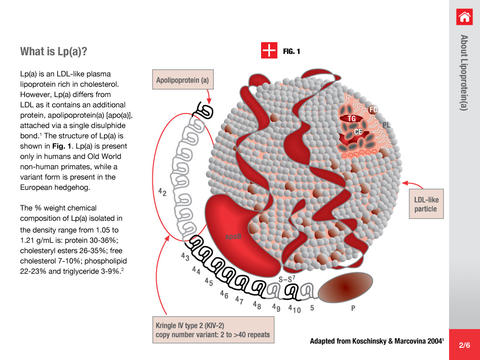What is Lipoprotein (a)?
Lipoprotein (a), also called Lp (a), is a modified form of LDL cholesterol bound to the protein apolipoprotein.
Elevated levels of lipoprotein (a) may promote atherosclerosis which is a risk factor for coronary artery disease.
There is a fundamental relationship of lipoprotein (a) excess with the risk of heart attack.
How am I at risk of a heart attack?
Lp (a) is a modified LDL (lousy cholesterol) in which a large protein, apolipoprotein (a) is bound to apolipoprotein B. Apolipoprotein (a) is a specific marker of Lp (a).The apolipoprotein (a) chain has five domains. One of the domains is similar to a fibrin-binding domain of plasminogen that dissolves clots. Because of the similar structure with plasminogen, Lp (a) interferes with the protein that dissolves clots.
Lp (a) also binds to a type of white blood cell that promotes the formation of fatty cells in the arterial walls called foam cells. Lp (a) deposits cholesterol into atherosclerotic plaques that narrow blood vessels in the heart. Inflammation begins within these plaques and leads to a thickening of the arterial wall. This further narrows the blood vessels depriving the heart muscle and body tissue of oxygen rich blood.
Therefore, plaque formation, inflammation and altered plasminogen activity increase the risk of heart attack.
Both genetic and environmental factors including age, sex, race, and ethnic background influence the risk of coronary artery disease.
What diseases can occur with high Lp (a) levels?
High Lp (a) levels in blood increases the risk for:
-
- Coronary artery disease (CAD)
- Cerebrovascular disease (CVD)
- Atherosclerosis
- Thrombosis
- Stroke
Who should be screened?
Patients with a moderate or high risk of cardiovascular disease are recommended to have their Lp (a) levels checked.
Any patient with the following risk factors should be screened.
-
- Premature cardiovascular disease
- Familial hypercholesterolemia
- Family history of premature cardiovascular disease
- Family history of elevated lipoprotein (a)
- Recurrent cardiovascular disease despite cholesterol lowering treatment with a statin drug
- ≥10% 10-year risk of fatal and/or non-fatal cardiovascular disease
There are no signs or symptoms of elevated lipoprotein (a), although Lp (a) levels are assessed by performing a simple blood test for an advanced lipid profile.
Even those who are not at risk are recommended to have an advanced lipid profile done at least once to assess accurate lipid levels.
How is it treated?
High Lp (a) levels are hard to treat, yet some medications are available to lower these levels.
The medications available to lower elevated Lp (a) levels are:
-
- Niacin (vitamin B3)
- Fibrate drugs (gemfibrozil/ fenofibrate)
Niacin 1-3 grams daily can reduce lipoprotein (a) levels by 20-30%.
Atorvastatin, aspirin, coenzyme Q10, L-carnitine, gingko biloba may be beneficial as well.
When elevated Lp (a) levels are discovered in a patient, attention towards other more easily treatable risk factors should be increased. These include high LDL cholesterol levels, smoking, and leading a sedentary lifestyle.
Lipoprotein (a) levels:
-
- Desirable < 14 mg/dL
- Borderline risk: 14-30 mg/dL
- High risk: 31-50 mg/dL
- Very high risk: >50 mg/dL

